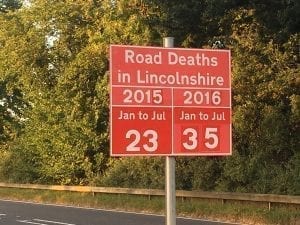How does the new driving test proposals fit in to improved road safety on Lincolnshire roads? Tom Ingram (Owner of BIG TOM Driving School) offers his opinion.

This was a photo taken recently on the A15 near Bourne which shows that when it comes to road safety in Lincolnshire, the picture is not good. This shows a 52% increase in fatalities when comparing the first half of 2016 with that of 2015. Taking a quick look at my Twitter feed, I see that for Jan – May 2014 it was 12 and for the same period in 2015 it was 17, a near on 42% increase. For the year of 2013 it was 36 and for 2014 42, a 17% increase.
We appear to be in the midst of a dramatic increase in road fatalities across the county. Taking a look at the Lincolnshire Road Safety Partnership website reveals the following stats since the year 2000:
2000 70 2001 88 2002 93 2003 104 2004 77 2005 69 2006 66 2007 79 2008 51 2009 52 2010 45 2011 47 2012 39 2013 36 2014 42
And as can be seen on the image, the figure up to July 2016 is already 35. These are worrying times, which begs the question why is this happening?
I have a background in Quality Assurance so have a tendency to want to dig deeper to attempt to analyse the root cause factors within a system. One of the key considerations when looking at any statistics is to be aware of the many factors that can contribute to the figures. Commonly, road safety still tends to be spoken of in terms of the 3 E’s: Education, Enforcement and Engineering. Of the three, the one that I personally have most involvement in is “Education”. The scope of this subject is wide. In a few weeks time I will be attending my local Grammar School for my yearly talk on road safety to near on 200 Year 12 pupils. In addition to this, I continue striving towards my goal in 2016 to introduce driving experience in a fun but safe environment to under 17 year olds. The introduction of a BTEC qualification prior to obtaining a provisional licence continues to gather momentum. But there will be many people who feel that the assessment system that is in the UK is inadequate. I regularly hear of people complaining that there should be more testing done of drivers throughout their life, including as they get older when reaction times and sight, hearing and spatial awareness levels can begin to reduce. Equally, there are plenty of people that I speak to on a regular basis that question the actual standard of driving attained by newly qualified drivers. There is arguably much to be said for this point of view. The Driver & Vehicle Standards Agency (DVSA) do continue to state that a significant amount of accidents are being caused by newly qualified drivers who have recently passed their test. The correlation between quantity of driving tests in the UK and fatalities in Lincolnshire is striking:
 As crude and seemingly superficial as this graphic is, it does demonstrate that the trend of fatalities in Lincolnshire is generally following the trend of driving tests being conducted in the UK from 2007-2014. Which opens up more questions relating to the system by which the industry trains and assesses how “ready” a newly qualified driver is for safe driving, independently after passing the driving test.
As crude and seemingly superficial as this graphic is, it does demonstrate that the trend of fatalities in Lincolnshire is generally following the trend of driving tests being conducted in the UK from 2007-2014. Which opens up more questions relating to the system by which the industry trains and assesses how “ready” a newly qualified driver is for safe driving, independently after passing the driving test.
The DVSA are indeed a key organisation in the UK. They stipulate the standard of driving expected of learner drivers, it controls the assessments of driving instructors as well as learner drivers. What it crucially does NOT do is control how learner drivers are trained; in fact in this country, learner drivers do not even have to be trained by driving instructors at all in order to take driving tests. It also does NOT control how driving instructors are trained; as before, there is no stipulation of the extent of training undertaken. As such, without any formal signing off of training by a professional trainer, we have in this country a system which means that learner drivers and trainee driving instructors have the freedom to limit the scope of their training at the standard of the assessment criteria of the tests set by the DVSA. It is generally acknowledged, even very recently by Lesley Young, the Chief Driving Examiner of the DVSA that the driving test is limited in its ability to test the ability of drivers to cope with driving at night, with a few friends in the car distracting the driver, or even to ask the most basic questions of drivers while on test to explain key road safety concepts. As a result of this fact, the industry is caught between 2 conflicting values. On the one hand the DVSA are keen to ensure that learning to drive does not become a privilege only for the financially able and yet, the evidence appears to be indicating that there is a battle between the “right to drive” versus the ability to ensure appropriate driving standards are met. Lesley Young is proposing that the average driving test is extended to increase by an average of 2 miles on each driving test, so as to enable the examiner to observe the candidate driving on faster, rural roads which are generally recognised as being the high risk roads for newly qualified drivers. As the owner of BIG TOM Driving School I very much welcome this change but believe it does not go far enough. On my intensive driving courses, my customers regularly drive over county boundaries, covering several dozens of miles and this is one of the strengths of the concept of the course. By nature of the design of the course, the trainer has the time to get the pupil driving greater distances, experiencing a wider range of driving conditions than is able to be accomplished on 1 or 2 hour driving lessons. It has long been my view that one of two things has to be changed; either the driving test standard required to pass is significantly increased which will in itself pull up the standards of training, or the syllabus of the driving training has to become formalised and compulsory so that training in such techniques as limit points on rural roads and commentary driving must be covered to a standard.
In my own experience, one of the key barriers to successful outcomes for raising driving standards, is observed by the quite understandable attitudes of the vast majority of learner drivers. We have an education system in this country that is based around a “transfer” of short-term factual knowledge that is assessed by how well a pupil is able to regurgitate that knowledge at critical times in the academic year. As such, generations of the population have become used to this concept of inwardly digesting factual information of very little relevance outside of the school environment, for a short timescale, purely for the purpose of then demonstrating that knowledge has seemingly been learnt. How long that knowledge is maintained, and what practical purpose it has for the individual is of little consequence because all the pupil is conditioned to strive for is good grades. As such pupils may not necessarily obtain any knowledge of practical use, but they do demonstrate that they are able to absorb and recall knowledge for a short period. Often, pupils will come out the other end of this process with feelings of low self-esteem and utter confusion of how the last dozen or so years of their lives really had any bearing on assisting them with identifying the skills that they have within them that will help them to enjoy life post-education.
The reason why this point is important is because these same young adults whilst in the process of enduring this situation they find thrust upon them that they have absolutely no control of, then have the prospect of learning to drive added to the expectations upon them. The consequence of this is that we have people learning to drive who have often had a pretty rotten ‘learning experience’ at school and college or university, they may not particularly welcome the prospect of starting yet further training having witnessed the demoralising outcomes of their schooling, and quite understandably they desire the quickest, most pain-free method of learning to drive that is available. Many learners will have been conditioned to conform to the educational constitution they have experienced of listen, obey and copy. As such, they will not by nature be willing (or practised) in absorbing information in a manner that they prefer in order to develop and apply driving skills that encourage long term road safety. This is one of the fundamental reasons why driving instructors will continue to observe pupils learning to drive who have very little knowledge of the theory; that information will have been lost from the short term memory soon after passing the theory test. It is also one of the fundamental reasons why your average learner does not have the required level of self-awareness to appreciate how their driving ability fits in with the standards required. They are only used to receiving feedback about academic work they have submitted and being told what to change, they have not been invited to take responsibility for the standards – they are used to repeatedly making attempts with no understanding of the required standard, until eventually the level they have obtained is sufficient. This is why at the time of writing the national driving test first time pass rate is only 21%.
The driving training industry has great challenges. The influence of the typical driving instructor is limited in terms of affecting outcomes. Far more influential to the attitudes from the typical learner driver will be the learning experience they have previously received and the affect that friends and family have on their driving behaviours. Quite naturally, how learners intend to drive can be significantly different to how they actually drive.
The reason why the driving training industry finds itself anchored in the quick sand of failure is because either of the two options highlighted above would be, by their very nature unpopular with the public. The DVSA have gone out of their way to say that the proposed new changes to the driving test will not be any more difficult in the technical competence of driving. The DVSA don’t want to be seen to be making “learning to drive” harder. In the current trials, the calibre of the driving instructors has not changed, the calibre of the candidates has not changed, the DVSA have stated that it is no more technically challenging, so it is difficult to understand how any increase in the pass rate of this new driving test can result in increased road safety for newly qualified drivers. If you re-jig a test but make it no more technically difficult, how can an increased pass rate be construed as raising standards, surely that is called “dumbing down”?
It would be a brave soul who proposed changes to the driving test that made it significantly more difficult to pass. Likewise, it seems very unlikely that any time soon we are going to see a change to the training of driving instructors and learner drivers that ensures higher quality driving training is provided. As long as driving instructors and learner drivers have complete freedom as to how much training they receive and how well they are trained, in terms of scope, there will be little change in improvement on road safety figures. It is in many ways highly desirable to see what is naturally developing, as we all wait for the “human element” of this problem to be taken out of our hands – what we then lose in freedom with driverless cars, we will truly gain in road safety.
BIG TOM Driving School Intensive Driving Courses in Peterborough, Spalding, Stamford, Grantham. Boston, Lincoln and Bourne Call NOW 0800 689 4174




